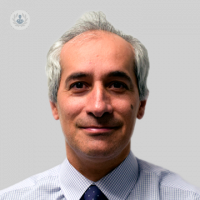Fine-tuning: can implantable lenses be adjusted after cataract surgery?
Escrito por:After cataract surgery, the natural lens of the eye is replaced with an implant. Nowadays, there are various options for the type of implanted lens you can have. But once the new lens implant is in the eye, can it be adjusted or changed? We asked expert ophthalmologist Mr Kaykhosrov Manuchehri for answers.

What kinds of lens implants can I get in cataract surgery?
There are several types of implantable lenses available:
- Toric – special implants shaped like a rugby ball, as opposed to a football. If you have astigmatism or your eyeball is rugby ball-shaped, we can put an appropriately shaped implant in the eye, reducing the post-operative astigmatism, and thus reducing people’s dependence on glasses as much as possible after the operation. Toric lens implants can be either monofocal or multifocal.
- Non-toric – these can also be monofocal or multifocal.
- Monofocal – these standard implants only have one focus: This focus can be set for either long distance, intermediate distance, or for near . However, the patient would need to wear glasses to see other distances clearly.
- Multi-focal implants – These implants have multiple focuses that allow the patient to see objects clearly at several distances. These were developed to get patients as glasses-free as possible. Originally these lens implants had only two focu
ses; now there are a whole range of multi-focal lensesimplants that provide three or more focuses (eg trifocal or extended range lens implants.)
Can my new implants be fine-tuned after cataract surgery?
Absolutely. This involves a short operation, in which a second lens implant – called a piggyback implant – is inserted on top of the already existing lens implant. The piggyback lens allows us to modify either the toricity or/and power of the original implant. This allows us to fine-tune the focus of the eye and to convert a lens implant from a monofocal to a multifocal.
Why is it necessary to fine-tune the lenses after cataract surgery?
Before we do cataract surgery, we take measurements of the eyeball, looking at the curvature of the cornea and axial length of the eye. These measurements are then put into a formula to estimate the size of the implant that the patient needs to see at the chosen distance (near, intermediate or far). These formulae have been refined over the years and are now more accurate than ever. Even so, they make certain assumptions which may not hold true for all patients. This means that for some patients, the predicted outcome may not materialise. To deal with these surprise outcomes, implants can be fine-tuned with a piggy-back lens implant to modify the focus of the first implant.
Other reasons why fine-tuning may be necessary include:
- The patient isn’t happy with the outcome of their cataract operation as was previously planned.
- The patient decides they want to become as spectacle-independent as possible after their operation. This may be because they have had a standard implant and wish to convert it to a multi-focal and/or toric lens implant in order to see better and more without glasses.
- The shape of the eyeball can sometimes change over time, meaning that patients can become spectacle-dependent again (this happens in 5-10% of cases) sometime after their original surgery. It is relatively simple to remove the old piggyback implant (if they have already had one) and put a new one in.
All in all, fine-tuning the implants is about modifying the outcome and correcting astigmatism and reducing the dependence on spectacles after cataract surgery.
What does fine-tuning the lens implants involve?
First, the patient has a consultation with a specialist to discuss what they want to achieve in terms of fine-tuning their implants.
Measurements will be made by opticians for glasses (post-operative refraction). Further measurements will be made by the consultant ophthalmologist. Based on these measurements, we make calculations using special formulae for the piggy-back lens implant size and type. The incision site will also be calculated using the measurements made. The piggyback lens implants are then ordered from the appropriate manufacturing company.
The patient comes into hospital for the procedure, which is very similar to cataract surgery, but quicker. The patient can almost always go home on the same day.
The operation is done under drop anaesthetic in an operating theatre. As with cataract surgery, there is a follow-up appointment the next day and again about two weeks after the operation. Eye drops are taken four times a day during this period, after which these are reduced gradually.
What are the advantages and risks?
The advantages are more-or-less the same as that of a cataract operation, although it is somewhat less risky because operation is much shorter.
Advantages:
- Piggyback lenses allow us to make patients vision as they like it and fine-tune focus if they were not happy with the original lens implant.
- Reduces spectacle dependence after cataract surgery.
Risks:
- Haemorrhage and infection (1in 10,000)
- Loss of vision (1 in 10,000)
These risks are very, very small. The risk of serious complications are less than 1/10,000.
For more information or to book an appointment, visit Mr Manuchehri’s Top Doctors profile.


